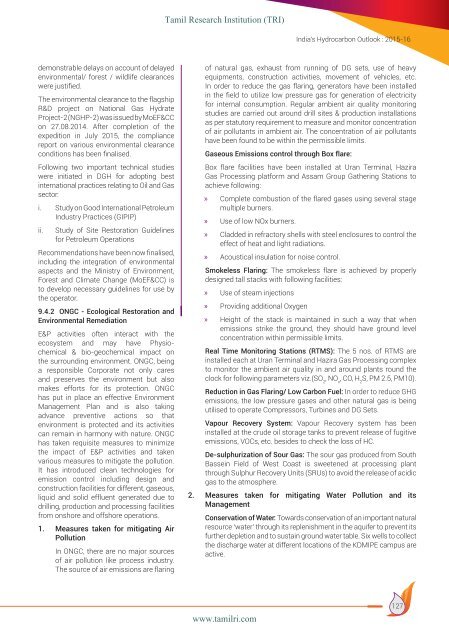HELP Hydrocarbon Exploration and Licensing Policy
Create successful ePaper yourself
Turn your PDF publications into a flip-book with our unique Google optimized e-Paper software.
Tamil Research Institution (TRI)<br />
India's <strong>Hydrocarbon</strong> Outlook : 2015-16<br />
demonstrable delays on account of delayed<br />
environmental/ forest / wildlife clearances<br />
were justified.<br />
The environmental clearance to the flagship<br />
R&D project on National Gas Hydrate<br />
Project-2 (NGHP-2) was issued by MoEF&CC<br />
on 27.08.2014. After completion of the<br />
expedition in July 2015, the compliance<br />
report on various environmental clearance<br />
conditions has been finalised.<br />
Following two important technical studies<br />
were initiated in DGH for adopting best<br />
international practices relating to Oil <strong>and</strong> Gas<br />
sector:<br />
i. Study on Good International Petroleum<br />
Industry Practices (GIPIP)<br />
ii.<br />
Study of Site Restoration Guidelines<br />
for Petroleum Operations<br />
Recommendations have been now finalised,<br />
including the integration of environmental<br />
aspects <strong>and</strong> the Ministry of Environment,<br />
Forest <strong>and</strong> Climate Change (MoEF&CC) is<br />
to develop necessary guidelines for use by<br />
the operator.<br />
9.4.2 ONGC - Ecological Restoration <strong>and</strong><br />
Environmental Remediation<br />
E&P activities often interact with the<br />
ecosystem <strong>and</strong> may have Physiochemical<br />
& bio-geochemical impact on<br />
the surrounding environment. ONGC, being<br />
a responsible Corporate not only cares<br />
<strong>and</strong> preserves the environment but also<br />
makes efforts for its protection. ONGC<br />
has put in place an effective Environment<br />
Management Plan <strong>and</strong> is also taking<br />
advance preventive actions so that<br />
environment is protected <strong>and</strong> its activities<br />
can remain in harmony with nature. ONGC<br />
has taken requisite measures to minimize<br />
the impact of E&P activities <strong>and</strong> taken<br />
various measures to mitigate the pollution.<br />
It has introduced clean technologies for<br />
emission control including design <strong>and</strong><br />
construction facilities for different, gaseous,<br />
liquid <strong>and</strong> solid effluent generated due to<br />
drilling, production <strong>and</strong> processing facilities<br />
from onshore <strong>and</strong> offshore operations.<br />
1. Measures taken for mitigating Air<br />
Pollution<br />
In ONGC, there are no major sources<br />
of air pollution like process industry.<br />
The source of air emissions are flaring<br />
of natural gas, exhaust from running of DG sets, use of heavy<br />
equipments, construction activities, movement of vehicles, etc.<br />
In order to reduce the gas flaring, generators have been installed<br />
in the field to utilize low pressure gas for generation of electricity<br />
for internal consumption. Regular ambient air quality monitoring<br />
studies are carried out around drill sites & production installations<br />
as per statutory requirement to measure <strong>and</strong> monitor concentration<br />
of air pollutants in ambient air. The concentration of air pollutants<br />
have been found to be within the permissible limits.<br />
Gaseous Emissions control through Box flare:<br />
Box flare facilities have been installed at Uran Terminal, Hazira<br />
Gas Processing platform <strong>and</strong> Assam Group Gathering Stations to<br />
achieve following:<br />
»»<br />
Complete combustion of the flared gases using several stage<br />
multiple burners.<br />
»»<br />
Use of low NOx burners.<br />
»»<br />
Cladded in refractory shells with steel enclosures to control the<br />
effect of heat <strong>and</strong> light radiations.<br />
»»<br />
Acoustical insulation for noise control.<br />
Smokeless Flaring: The smokeless flare is achieved by properly<br />
designed tall stacks with following facilities:<br />
»»<br />
Use of steam injections<br />
»»<br />
Providing additional Oxygen<br />
»»<br />
Height of the stack is maintained in such a way that when<br />
emissions strike the ground, they should have ground level<br />
concentration within permissible limits.<br />
Real Time Monitoring Stations (RTMS): The 5 nos. of RTMS are<br />
installed each at Uran Terminal <strong>and</strong> Hazira Gas Processing complex<br />
to monitor the ambient air quality in <strong>and</strong> around plants round the<br />
clock for following parameters viz.(SO 2<br />
, NO x<br />
, CO, H 2<br />
S, PM 2.5, PM10).<br />
Reduction in Gas Flaring/ Low Carbon Fuel: In order to reduce GHG<br />
emissions, the low pressure gases <strong>and</strong> other natural gas is being<br />
utilised to operate Compressors, Turbines <strong>and</strong> DG Sets.<br />
Vapour Recovery System: Vapour Recovery system has been<br />
installed at the crude oil storage tanks to prevent release of fugitive<br />
emissions, VOCs, etc. besides to check the loss of HC.<br />
De-sulphurization of Sour Gas: The sour gas produced from South<br />
Bassein Field of West Coast is sweetened at processing plant<br />
through Sulphur Recovery Units (SRUs) to avoid the release of acidic<br />
gas to the atmosphere.<br />
2. Measures taken for mitigating Water Pollution <strong>and</strong> its<br />
Management<br />
Conservation of Water: Towards conservation of an important natural<br />
resource ‘water’ through its replenishment in the aquifer to prevent its<br />
further depletion <strong>and</strong> to sustain ground water table. Six wells to collect<br />
the discharge water at different locations of the KDMIPE campus are<br />
active.<br />
www.tamilri.com<br />
127


















